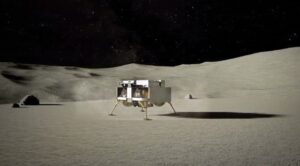Runner-up in NASA commercial lunar lander competition plans to try again

SANTA FE, N.M. — The one company that failed to win a NASA contract last month for commercial lunar payload delivery services says it will try again in the future as it continues development of its lunar lander.
NASA awarded contracts to nine companies Nov. 29 for its Commercial Lunar Payload Services (CLPS) program, where NASA will buy payload space on landers those companies are developing to transport experiments to the surface of the moon. The indefinite delivery, indefinite quantity contracts, with a combined maximum value of $2.6 billion over 10 years, don’t guarantee the companies will receive anything more than a token amount of money but do allow them to compete for future task orders.
At the time of the announcement NASA provided few additional details about the competition, including the total number of companies who submitted proposals. A source selection statement, released by NASA Dec. 20, revealed that all but one of the companies that submitted proposals received contracts.
Besides the nine companies that received CLPS awards — Astrobotic, Deep Space Systems, Draper, Firefly Aerospace, Intuitive Machines, Lockheed Martin, Masten Space Systems, Moon Express and Orbit Beyond — a tenth company, Crow Industries, submitted a proposal that the agency concluded was not acceptable.
NASA judged the CLPS proposals in five categories, including a company’s ability to carry out a lunar lander mission with at least 10 kilograms of payload by the end of 2021, understanding of regulatory issues, launch plans, spacecraft design and plans for integrating NASA payloads. All nine of the winning companies rated as “Acceptable” in each of the five categories.
Crow Industries, however, received “Unacceptable” rating in two categories, its ability to get to the moon by the end of 2021 and its spacecraft design. It received a “Potentially Acceptable” score in a third category, payload processing procedures.
NASA was skeptical that the company would be able to develop its lander on the schedule it proposed. “Crow’s proposed development schedule was not credible and did not adequately address or identify its path for or milestones associated with engine system development,” the source evaluation board concluded in the statement regarding the company’s “Unacceptable” schedule score.
The board also concluded that “Crow’s proposed mass budget was not credible for its payload mass and that its mass estimate for its main engines was also not credible” in its explanation of an “Unacceptable” score for spacecraft design.
The “Potentially Acceptable” score for payload processing stemmed from a lack of information in several areas, such as payload integration and physical security. Those issues could be remedied with additional information, the board concluded.
Dennis Andrucyk, deputy associate administrator in NASA’s Science Mission Directorate and the source selection authority for CLPS, accepted those scores after what he described in the statement as “fulsome discussion” with the board. “In light of the foregoing reasons, I find that Crow’s proposal is currently ineligible for award of a CLPS base contract and therefore do not select Crow for an award,” he concluded.
He left the door open, though, for Crow to compete in the future. The CLPS program, he noted, “anticipates that the Agency may make additional awards at regular intervals through an ‘on-ramp’ process.” He wrote that it’s “entirely conceivable” that Crow could remedy its problems “in a manner that could render Crow eligible for award of a CLPS base contract in the future.”
Crow Industries is also hoping to compete again for a CLPS contract. Ellyn Heald, director of communications for the Arizona-based startup, said Dec. 21 that the company proposed its B1 lander, the first in the company’s Bifröst series of spacecraft.
“As stated in the source selection statement, while NASA found many of the aspects of our offering compelling, our Bifröst lander architecture is still in the early stages of its development, and their primary concern was related to the timeline required to deliver the innovative design of our main engines,” Heald said.
The company hasn’t disclosed many technical details about the Bifröst lander program, including the engines. The company hasn’t disclosed financial details as well, although the NASA source selection statement noted that Crow had “an adequate financial plan.” Crow did publish a video in October that showed a B1 lander touching down on the moon. The rover deployed two small rovers and used a robotic arm to collect lunar samples.
“Despite not being selected for this CLPS opportunity, we are confident that the areas of improvement NASA pointed to will be resolved soon,” Heald said, with plans to offer lander services to government and commercial customers. “We look forward to improving on our systems and joining the selected CLPS offerors through the next onramp opportunity in two years.”
from SpaceNews.com http://bit.ly/2ETKdz5
Comments
Post a Comment